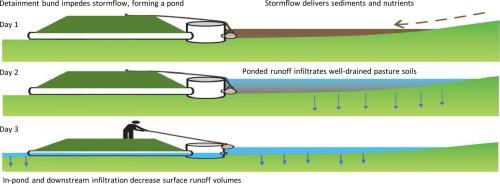当前位置:
X-MOL 学术
›
Agric. Water Manag.
›
论文详情
Our official English website, www.x-mol.net, welcomes your feedback! (Note: you will need to create a separate account there.)
The ability of detainment bunds to decrease surface runoff leaving pastoral catchments: Investigating a novel approach to agricultural stormwater management
Agricultural Water Management ( IF 6.7 ) Pub Date : 2021-01-01 , DOI: 10.1016/j.agwat.2020.106423 Brian Levine , Dave Horne , Lucy Burkitt , Chris Tanner , James Sukias , Leo Condron , John Paterson
Agricultural Water Management ( IF 6.7 ) Pub Date : 2021-01-01 , DOI: 10.1016/j.agwat.2020.106423 Brian Levine , Dave Horne , Lucy Burkitt , Chris Tanner , James Sukias , Leo Condron , John Paterson

|
Abstract Storm generated surface runoff is responsible for significant portions of the contaminants exported from grazed pastures that contribute to water quality impairment in inland and coastal waters. Detainment bunds (DBs) were investigated as a novel strategy to mitigate the losses of nutrients and sediment in surface runoff from pastures in the Lake Rotorua catchment, in New Zealand. A DB is a ∼1.5-2 m high earthen stormwater retention structure constructed on productive pastures in the flow path of targeted ephemeral streams. The current DB design protocol recommends a minimum pond volume of 120 m3 per hectare of contributing catchment. Bunds are capable of temporarily ponding up to 10,000 m3 of surface runoff, which can be rapidly drained by opening an outlet valve. This 12-month study of 2 DB sites with 55 ha and 20 ha subcatchments in the Lake Rotorua catchment, found that DBs effectively decreased annual discharge volumes by 31% and 43%. Decreased runoff discharges were the result of increased soil infiltration facilitated by increased stormwater residence times on well-drained soils in the ponding area. Furthermore, discharges from the DBs occurring after runoff generation in the catchment had ceased were likely to infiltrate the soils downstream of the DBs. Combining the in-pond and downstream infiltration, the DBs prevented 43% and 63% of the annual runoff generated in the targeted catchments from reaching downstream surface waters. The results of this study demonstrate that DBs constructed on sufficiently permeable soils reduce surface runoff volumes from pastures, and are thereby capable of decreasing contaminant loads delivered to receiving surface waters. As such, DBs are likely to be an effective strategy to add to the nutrient mitigation toolbox in the Lake Rotorua catchment, and in other pastoral locations where contaminants mobilised by surface runoff contribute to water quality degradation.
中文翻译:

滞留堤岸减少离开牧区集水区的地表径流的能力:调查农业雨水管理的新方法
摘要 风暴产生的地表径流是放牧牧场输出污染物的重要原因,这些污染物导致内陆和沿海水域的水质受损。滞留堤 (DB) 被研究作为一种新策略,以减轻新西兰罗托鲁瓦湖集水区牧场地表径流中养分和沉积物的损失。DB 是一个约 1.5-2 m 高的土制雨水蓄水结构,建在目标短暂溪流的流动路径中的生产牧场上。当前的 DB 设计协议建议每公顷贡献集水区的最小池塘容积为 120 立方米。堤坝能够临时蓄积多达 10,000 立方米的地表径流,可通过打开出口阀门快速排出。对罗托鲁瓦湖流域中 55 公顷和 20 公顷子汇水面积的 2 个 DB 站点进行的为期 12 个月的研究发现 DB 有效地将年排放量减少了 31% 和 43%。径流排放减少是由于雨水在蓄水区排水良好的土壤上停留时间增加而促进土壤渗透增加的结果。此外,在集水区径流生成停止后发生的 DBs 排放很可能渗入 DBs 下游的土壤。结合池塘内和下游的渗透,DB 阻止了目标集水区产生的 43% 和 63% 的年径流到达下游地表水。这项研究的结果表明,在足够透水的土壤上建造的 DBs 减少了牧场的地表径流量,从而能够减少输送到接收地表水的污染物负荷。因此,DBs 可能是一种有效的策略,可以添加到罗托鲁瓦湖集水区和其他牧区的养分缓解工具箱中,在这些地方,地表径流迁移的污染物导致水质下降。
更新日期:2021-01-01
中文翻译:

滞留堤岸减少离开牧区集水区的地表径流的能力:调查农业雨水管理的新方法
摘要 风暴产生的地表径流是放牧牧场输出污染物的重要原因,这些污染物导致内陆和沿海水域的水质受损。滞留堤 (DB) 被研究作为一种新策略,以减轻新西兰罗托鲁瓦湖集水区牧场地表径流中养分和沉积物的损失。DB 是一个约 1.5-2 m 高的土制雨水蓄水结构,建在目标短暂溪流的流动路径中的生产牧场上。当前的 DB 设计协议建议每公顷贡献集水区的最小池塘容积为 120 立方米。堤坝能够临时蓄积多达 10,000 立方米的地表径流,可通过打开出口阀门快速排出。对罗托鲁瓦湖流域中 55 公顷和 20 公顷子汇水面积的 2 个 DB 站点进行的为期 12 个月的研究发现 DB 有效地将年排放量减少了 31% 和 43%。径流排放减少是由于雨水在蓄水区排水良好的土壤上停留时间增加而促进土壤渗透增加的结果。此外,在集水区径流生成停止后发生的 DBs 排放很可能渗入 DBs 下游的土壤。结合池塘内和下游的渗透,DB 阻止了目标集水区产生的 43% 和 63% 的年径流到达下游地表水。这项研究的结果表明,在足够透水的土壤上建造的 DBs 减少了牧场的地表径流量,从而能够减少输送到接收地表水的污染物负荷。因此,DBs 可能是一种有效的策略,可以添加到罗托鲁瓦湖集水区和其他牧区的养分缓解工具箱中,在这些地方,地表径流迁移的污染物导致水质下降。



























 京公网安备 11010802027423号
京公网安备 11010802027423号